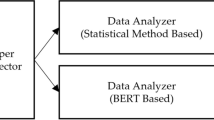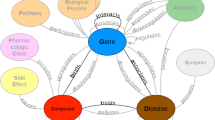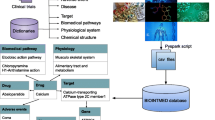Abstract
In order to capitalize on the extensive biological research publications and databases, knowledge graphs can help extract clinically useful details from large and complicated resources. Here, we compare utility of knowledge graphs and named entity extraction for identifying biologically appropriate results from breast cancer subtyping publications. This biomedical field is an excellent representative test set - the biological mechanisms are well studied but complex, while the clinical applications of identifying breast cancer subtypes are critical to making appropriate diagnostic and therapeutic considerations. Optimizing knowledge graphs to extract actionable biological details rapidly and accurately could have huge implications in translating biological data into clinical care responses. Our research suggests that limitations exist in current knowledge graph pipelines in biomedical data analysis, primarily related to named entity extraction issues.
Access this chapter
Tax calculation will be finalised at checkout
Purchases are for personal use only
Similar content being viewed by others
References
Bastien, R.R., et al.: Pam50 breast cancer subtyping by RT-QPCR and concordance with standard clinical molecular markers. BMC Med. Genom. 5(1), 1–12 (2012)
Blows, F.M., et al.: Subtyping of breast cancer by immunohistochemistry to investigate a relationship between subtype and short and long term survival: a collaborative analysis of data for 10,159 cases from 12 studies. PLoS Med. 7(5), e1000279 (2010)
Burstein, H.J.: The distinctive nature of her2-positive breast cancers. New Engl. J. Med. 353(16), 1652–1654 (2005)
Callahan, T.J., Tripodi, I.J., Pielke-Lombardo, H., Hunter, L.E.: Knowledge-based biomedical data science. Ann. Rev. Biomed. Data Sci. 3, 23–41 (2020)
Chia, S.K., et al.: A 50-gene intrinsic subtype classifier for prognosis and prediction of benefit from adjuvant tamoxifen. Clin. Cancer Res. 18(16), 4465–4472 (2012)
Curtis, C., et al.: The genomic and transcriptomic architecture of 2,000 breast tumors reveals novel subgroups. Nature 486, 346–352 (2012)
Dai, X., et al.: Breast cancer intrinsic subtype classification, clinical use and future trends. Am. J. Cancer Res. 5(10), 2929 (2015)
Fadare, O., Tavassoli, F.A.: Clinical and pathologic aspects of basal-like breast cancers. Nat. Clin. Pract. Oncol. 5(3), 149–159 (2008)
Gunduz, C., Yener, B., Gultekin, S.H.: The cell graphs of cancer. Bioinformatics 20(suppl_1), i145–i151 (2004)
Horr, C., Buechler, S.A.: Breast cancer consensus subtypes: a system for subtyping breast cancer tumors based on gene expression. NPJ Breast Cancer 7(1), 1–13 (2021)
Ignatiadis, M., Sotiriou, C.: Luminal breast cancer: from biology to treatment. Nat. Rev. Clin. Oncol. 10(9), 494–506 (2013)
Koboldt, D., et al.: Comprehensive molecular portraits of human breast tumours. Nature 490(7418), 61–70 (2012)
Lakis, S., et al.: The androgen receptor as a surrogate marker for molecular apocrine breast cancer subtyping. The Breast 23(3), 234–243 (2014)
Liu, Z., Zhang, X.S., Zhang, S.: Breast tumor subgroups reveal diverse clinical prognostic power. Sci. Rep. 4, 4002 (2014). https://europepmc.org/articles/PMC5379255
Neumann, M., King, D., Beltagy, I., Ammar, W.: Scispacy: Fast and robust models for biomedical natural language processing. arXiv preprint arXiv:1902.07669 (2019)
Nicholson, D.N., Greene, C.S.: Constructing knowledge graphs and their biomedical applications. Comput. Struct. Biotechnol. J. 18, 1414–1428 (2020)
Rontogianni, S., et al.: Proteomic profiling of extracellular vesicles allows for human breast cancer subtyping. Commun. Biol. 2(1), 1–13 (2019)
Rossanez, A., Dos Reis, J.C., Torres, R.D.S., de Ribaupierre, H.: Kgen: a knowledge graph generator from biomedical scientific literature. BMC Med. Inf. Decis. Mak. 20(4), 1–24 (2020)
Shibahara, T., et al.: Deep learning generates custom-made logistic regression models for explaining how breast cancer subtypes are classified. bioRxiv (2021)
Sims, A.H., Howell, A., Howell, S.J., Clarke, R.B.: Origins of breast cancer subtypes and therapeutic implications. Nat. Clin. Pract. Oncol. 4(9), 516–525 (2007)
Sung, H., et al.: Global cancer statistics 2020: globocan estimates of incidence and mortality worldwide for 36 cancers in 185 countries. CA Cancer J. Clin. 71(3), 209–249 (2021)
Sung, M., Jeong, M., Choi, Y., Kim, D., Lee, J., Kang, J.: Bern2: an advanced neural biomedical named entity recognition and normalization tool. arXiv preprint arXiv:2201.02080 (2022)
Troester, M.A., Swift-Scanlan, T.: Challenges in studying the etiology of breast cancer subtypes. Breast Cancer Res. BCR 11(3), 104 (2009). https://europepmc.org/articles/PMC2716506
Yan, J., Wang, C., Cheng, W., Gao, M., Zhou, A.: A retrospective of knowledge graphs. Front. Comput. Sci. 12(1), 55–74 (2018). https://doi.org/10.1007/s11704-016-5228-9
Zardavas, D., Irrthum, A., Swanton, C., Piccart, M.: Clinical management of breast cancer heterogeneity. Nat. Rev. Clin. Oncol. 12(7), 381–394 (2015)
Author information
Authors and Affiliations
Corresponding author
Editor information
Editors and Affiliations
Rights and permissions
Copyright information
© 2022 Springer Nature Switzerland AG
About this paper
Cite this paper
Davidson, J. et al. (2022). Comparisons of Knowledge Graphs and Entity Extraction in Breast Cancer Subtyping Biomedical Text Analysis. In: Rojas, I., Valenzuela, O., Rojas, F., Herrera, L.J., Ortuño, F. (eds) Bioinformatics and Biomedical Engineering. IWBBIO 2022. Lecture Notes in Computer Science(), vol 13347. Springer, Cham. https://doi.org/10.1007/978-3-031-07802-6_21
Download citation
DOI: https://doi.org/10.1007/978-3-031-07802-6_21
Published:
Publisher Name: Springer, Cham
Print ISBN: 978-3-031-07801-9
Online ISBN: 978-3-031-07802-6
eBook Packages: Computer ScienceComputer Science (R0)




